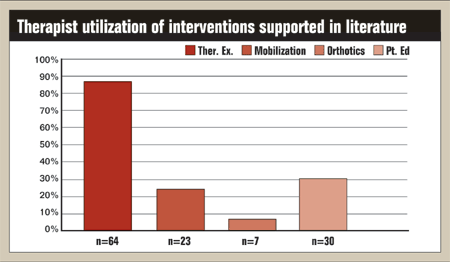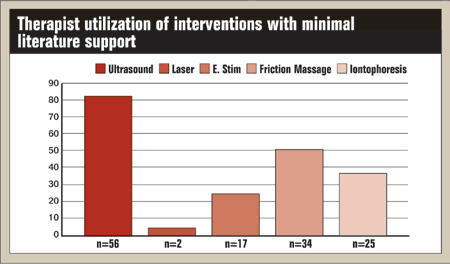Knowledge of supporting literature helpful when deciding between hand interventions
Understanding how efficacious an intervention has been found to be is imperative to clinical success.
Click Here to Manage Email Alerts
SAN FRANCISCO — A keen awareness of the literature supporting the interventions hand therapists make use of in their clinical practices is essential to making treatment as efficacious as possible, according to a study presented here.
Kristin Valdes, OTD, OTR, CHT, presented her paper at the 2009 Combined Annual Meeting of the American Society for Surgery of the Hand and the American Society of Hand Therapists (ASHT).
“The purpose of this descriptive study was to determine what interventions hand therapists use in daily practice and how much time is spent performing each intervention,” Valdes said.
Moderator Susan Michlovitz, PT, PhD, CHT, praised Valdes for her study and labeled it “important.”
Study parameters
Valdes’s study surveyed 109 hand therapists who attended an evidence-based medicine course at the 2008 ASHT conference. Therapists were asked to report the clinical interventions they utilized for the treatment of lateral epicondylosis and the percentage of daily treatment time each intervention was utilized.
The surveys were collected at the conclusion of the course, and the data was analyzed.
Valdes said of the 109 questionnaires returned, 68 were used for data interpretation. The 41 questionnaires that were not used were rejected because their percentage of interventions did not add up to 100% of the total treatment time.
Exercises, mobilizations, orthotics and patient education were reported in the study to have been supported by current literature. Ultrasound, laser, electrical stimulation, deep-friction massage and iontophoresis were all said to have minimal support.
The survey found that therapeutic exercises were the most frequently utilized intervention (94.1%). Ultrasound was the second-most frequently utilized (82.3%). The use of literature-supported interventions such as mobilization (33.8%), orthotics (10.3%) and patient education (44.1%), as well as the use of interventions unsupported by literature — such as laser (2.9%), electric stimulation (25%), massage (50%) and iontophoresis (36.8%) — were all noted.
“There is no literature that supports the efficacy of heat modalities or taping for sustained pain relief in patients with lateral epicondylosis,” Valdes added. “The therapists who reported they are using heat are spending 29% — and taping, 21% — of the patient’s treatment time performing the interventions.”
|
Image: Valdes K. |
Literature support
“The study demonstrates that hand therapists are using a variety of interventions that have literature support in the treatment of their patients with the diagnosis of lateral epicondylosis,” Valdes said, adding, however, “therapists are also spending patient treatment time utilizing interventions that do not have support in the current literature.”
In the study, the authors suggest that the insufficient evidence for some of these interventions comes from contradictory results, insufficient power within studies and a low number of studies per intervention.
Valdes said the findings indicate a need for therapists to understand the literature supporting or criticizing the efficacy of their respective intervention methods.
“To improve the quality of care in clinical practice, therapists must be aware of the level of evidence present in the literature that supports the interventions they are using, and be open to the possibility that no intervention may be the most efficacious intervention,” Valdes concluded.
“Good take-home points”
Michlovitz commended Valdes for her survey and stressed the importance of the findings to the audience.
“You bring a couple of good take-home points, and one of those is the suggestion to the therapists in the audience that they go back to their clinical practices with the descriptive statistics that the investigators have supplied,” Michlovitz said. “Try to see what the practice patterns are in your location, and try to match them with the published evidence.”
For more information:Susan L. Michlovitz, PhD, PT, CHT is a physical therapist and Certified Hand Therapist and the owner of Cayuga Hand Therapy PT, a physical therapy private practice. She can be reached at 903 Hanshaw Road, Ithaca, NY 14850-1530; 607-229-2165; e-mail: cayugahandtherapy@g-mail.com. She has no direct or financial interests with any company or product mentioned in this article.
Kristin Valdes, OTD, OTR, CHT, is an occupational therapist and Certified Hand Therapist with Hand Works Physical Therapy, 2616 Bee Ridge Road, Sarasota, FL 34239-6415; 941-927-6862; e-mail: hotglassgal@comcast.net. She has no direct or financial interests with any company or product mentioned in this article.
- Reference:
Valdes K, Marik T, Bodell GK. Are hand therapists implementing evidence-based medicine into daily practice? Best Paper 4. Presented at the 2009 Combined Annual Meeting of the American Society for Hand Therapists and the American Society for Surgery of the Hand. Sept. 3-5, 2009. San Francisco.


